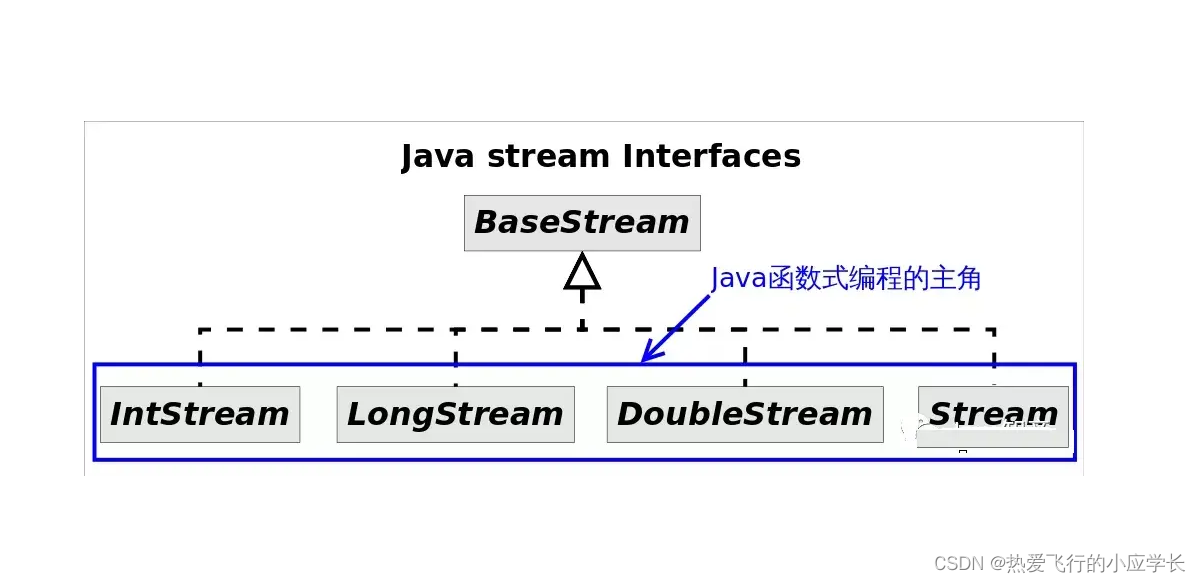Java十分钟快速掌握Stream流
1、什么是Stream流:
Stream 是Java 8 提出的一个新概念,不是输入输出的 Stream 流 (和IO流其实没有任何关系哈),而是一种使用函数式编程方式在集合类上进行操作的工具。简而言之,是以内部迭代的方式处理集合数据的操作,内部迭代可以将更多的控制权交给集合类。Stream 和 Iterator 的功能类似,只是Iterator 是以外部迭代的形式处理集合数据的操作。
当然Stream也有自己特性:
- 不是一种数据结构,不会存数据,只是在原数据集上定义了一组操作
- 这些操作是惰性的,即每当访问到流中的一个元素,才会在此元素上执行这一系列操作
- 因为不保存数据,故每个Stream流只能使用一次。
Stream流的实现图:

2、创建流:
想要用Stream流来操作集合,那么就需要将数组或者集合先转换成Stream流才可以操作
Stream的官方文档:
https://docs.oracle.com/en/java/javase/17/docs/api/java.base/java/util/stream/Stream.html
先来看四个方法:
- filter:通过lambda表达式来实现条件过滤
- limit:截取流,截取一段流
- skip:跳过流
- distinct:去除重复
创建Stream:
public class Test {
public static void main(String[] args) {
String [] arr = {"东","南","西","北"};
//将数组转换成Stream
Stream<String> stream = Arrays.stream(arr);
stream = Stream.of(arr);
stream = Stream.of("东","南","西","北");
//将list集合转换成stream
List<String> list = Arrays.asList("aa","cc","bb","aa","dd");
stream = list.stream();
//排序、去重、遍历
list.stream().sorted().distinct().forEach(System.out::println);
//用过Stream流操作完集合后还可以再转换成一个新的集合
List<String> newList = list.stream().sorted().distinct().collect(Collectors.toList());
System.out.println(newList.toString());
}
}
输出:
//遍历并去重后的结果:
aa
bb
cc
dd
//用过Stream流操作完集合后还可以再转换成一个新的集合
[aa, bb, cc, dd]
四个方法的操作:
Person类:
这个类代码比较多,所有不把get/set方法写进去了,大家的使用的时候别忘!!
public class Person {
private String name;
private Integer age;
private String country;
private char sex;
@Override
public String toString() {
return "信息表:{" +
"name='" + name + '\'' +
", age=" + age +
", country='" + country + '\'' +
", sex=" + sex +
'}';
}
//这里节省的get/set代码
//重写toString() 和 equals 和 hashcode 方法
@Override
public boolean equals(Object o){
if(this == o)
return true;
if(o == null || getClass() != o.getClass())
return false;
Person person = (Person) o;
if(country != null){
if(this.country.equals(person.country)){
return true;
}else{
return false;
}
}
return false;
}
@Override
public int hashCode(){
return Objects.hash(country);
}
}
测试类:
结合了lambda表达式来写
public class Test {
public static void main(String[] args) {
List<Person> perosnList = new ArrayList<>();
perosnList.add(new Person("王一", 30, "中国", 'M'));
perosnList.add(new Person("张三", 19, "美国", 'F'));
perosnList.add(new Person("李四", 29, "日本", 'F'));
perosnList.add(new Person("小美", 74, "英国", 'M'));
perosnList.add(new Person("熊二", 15, "意大利", 'F'));
perosnList.add(new Person("熊大", 66, "韩国", 'F'));
//返回年龄大于20岁的学生集合
System.out.println("返回年龄大于20岁的学生集合");
perosnList.stream().filter(p -> p.getAge() > 20).forEach(System.out::println);
//返回年龄大于50岁的学生集合
System.out.println("返回年龄大于50岁的集合");
List<Person> list = perosnList.stream().filter(p -> p.getAge() > 50).collect(Collectors.toList());
System.out.println(list);
//返回年龄大于20岁的中国学生
System.out.println("返回年龄大于20岁的中国人");
perosnList.stream().filter(p -> p.getAge() > 20).filter(p -> p.getCountry().equals("韩国")).forEach(System.out::println);
//年龄大于20 中国 性别M
System.out.println("返回年龄大于20 中国 性别M");
perosnList.stream().filter(p -> p.getAge() > 20 && p.getCountry().equals("中国") && p.getSex() == 'M').forEach(System.out::println);
}
}
看看结果:
返回年龄大于20岁的学生集合
信息表:{name='王一', age=30, country='中国', sex=M}
信息表:{name='李四', age=29, country='日本', sex=F}
信息表:{name='小美', age=74, country='英国', sex=M}
信息表:{name='熊大', age=66, country='韩国', sex=F}返回年龄大于50岁的集合
[信息表:{name='小美', age=74, country='英国', sex=M}, 信息表:{name='熊大', age=66, country='韩国', sex=F}]返回年龄大于20岁的中国人
信息表:{name='熊大', age=66, country='韩国', sex=F}返回年龄大于20 中国 性别M
信息表:{name='王一', age=30, country='中国', sex=M}
小结:
使用Stream流可以容易操作数组或者集合,可以结合Lambda表达式,可以让一句表达式整洁明了,其实既然是Java退出的新特性,那么肯定是有用处的。
3、Stream的map映射流
public class Test {
public static void main(String[] args) {
//map的作用是迭代取到每个list元素,再通过map里面的函数进行相应的操作
List<String> list1 = Arrays.asList("a","bb","ccc","dddd");
//通过map取到每个集合元素的长度并返回
Stream<Integer> stream = list1.stream().map(p->p.length());
stream.forEach(System.out::println);
System.out.println("----------------");
List<String> userList = new ArrayList<>();
userList.add("周杰伦.tom");
userList.add("尼古拉斯.赵四");
userList.add("牛顿.巴基斯");
userList.add("赵少华.思密达");
List<String> uList = userList.stream().map(p->p.substring(p.indexOf(".")+1,
p.length())).collect(Collectors.toList());
System.out.println(uList.toString());
}
}
输出:
1
2
3
4
----------------
[tom, 赵四, 巴基斯, 思密达]
4、Stream查找与匹配
Stream内还有一个 anyMatch(Predicate<? super T> predicate) 的方法:
返回此流中的任何元素是否匹配所提供的词
Demo:
public class Test {
public static void main(String[] args) {
List<String> list = Arrays.asList("周杰伦","王力宏","孙燕姿","林俊杰");
boolean flag1 = list.stream().anyMatch(ele->ele.contains("燕"));
System.out.println("有没有名字包含燕的同学:"+flag1);
//判断开头:
boolean flag2 = list.stream().anyMatch(ele->ele.startsWith("王"));
System.out.println("有没有名字开头是王的同学:"+flag2);
//判断结尾:
boolean flag3 = list.stream().anyMatch(ele->ele.endsWith("杰"));
System.out.println("有没有名字结尾是杰的同学:"+flag3);
// anyMatch是匹配所有的,要满足条件
boolean flag4 = list.stream().anyMatch(ele->ele.length()>2);
System.out.println("所有同学的名字都是两个字以上的吗"+flag4);
boolean flag5 = list.stream().anyMatch(ele->ele.startsWith("王"));
System.out.println("所有同学的名字都有王吗?"+flag5);
//noneMatch
boolean flag6 = list.stream().noneMatch(ele->ele.contains("燕"));
System.out.println("集合中都没有包含'燕'这个字吗"+flag5);
}
}
输出:
有没有名字包含燕的同学:true
有没有名字开头是王的同学:true
有没有名字结尾是杰的同学:true
所有同学的名字都是两个字以上的吗true
所有同学的名字都有王吗?true
集合中都没有包含'燕'这个字吗true
使用anyMatch()里面的方法可以很容易对这个流的信息匹配。
最后附上一张Stream流的方法速记图啦:

到此这篇关于Java十分钟快速掌握Stream流的文章就介绍到这了,更多相关Java Stream流内容请搜索我们以前的文章或继续浏览下面的相关文章希望大家以后多多支持我们!

